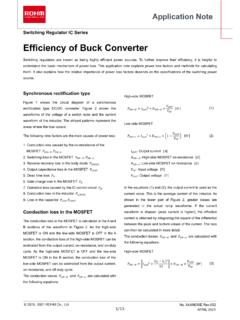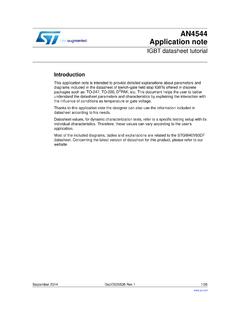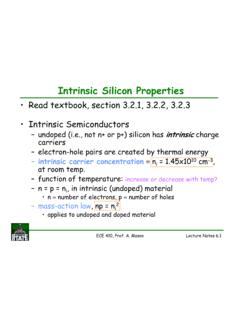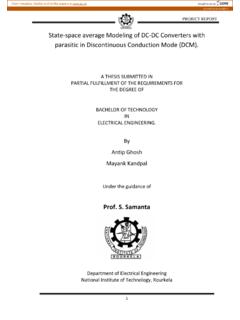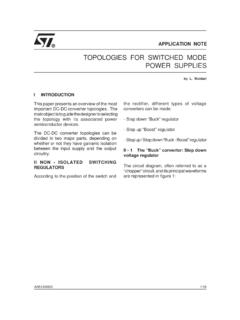Transcription of Chapter 2 Semiconductor Heterostructures - Cornell …
1 Semiconductor Optoelectronics (Farhan Rana, Cornell University) Chapter 2 Semiconductor Heterostructures Introduction Most interesting Semiconductor devices usually have two or more different kinds of semiconductors . In this handout we will consider four different kinds of commonly encountered Heterostructures : a) pn heterojunction diode b) nn heterojunctions c) pp heterojunctions d) Quantum wells, quantum wires, and quantum dots A pn Heterojunction Diode Consider a junction of a p-doped Semiconductor ( Semiconductor 1) with an n-doped Semiconductor ( Semiconductor 2). The two semiconductors are not necessarily the same, 1 could be AlGaAsand 2 could be assume that 1 has a wider band gap than 2. The band diagrams of 1 and 2 by themselves are shown below.
2 Electron Affinity Rule and Band Alignment: How does one figure out the relative alignment of the bands at the junction of two different semiconductors ? For example, in the Figure above how do we know whether the conduction band edge of Semiconductor 2 should be above or below the conduction band edge of Semiconductor 1? The answer can be obtained if one measures all band energies with respect to one value. This value is provided by the vacuum level (shown by the dashed line in the Figure above). The vacuum level is the energy of a free electron (an electron outside the Semiconductor ) which is at rest with respect to the Semiconductor . The electron affinity, denoted by (units: eV), of a Semiconductor is the energy required to move an electron from the conduction band bottom to the vacuum level and is a material constant.
3 The electron affinity rule for band alignment says that at a heterojunction between different semiconductors the relative alignment of bands is dictated by their electron affinities, as shown in the Figure above. The electron affinity rule implies that the conduction band offset at a heterojunction interface is equal to the difference in the Ec1 Ef1 Ev1 Ec2 Ef2 Ev2 q 1 q 2 Eg1 Eg2 Vacuum level Semiconductor Optoelectronics (Farhan Rana, Cornell University) electron affinities between the two semiconductors . This is shown in the band diagram below. According to the electron affinity rule the conduction band offset cE is given as, 12 qEc The valence band offset is then, cgcggvEEEEEE 21 Note that, gvcEEE Depending upon the difference between 1 and 2 we could have type I, type II, or type III heterojunction interfaces, as shown below.
4 Ec1 Ef1 Ev1 Ec2 Ef2 Ev2 q 1 q 2 Eg1 Eg2 Vacuum level Ec Ev q 1 q 2 q 1 q 2 q 1 q 2 Type I interfaceType II interface (Staggered gaps) Type III interface (Broken gaps) Semiconductor Optoelectronics (Farhan Rana, Cornell University) The affinity rule does not always work well. The reason is that it attempts to use a bulk property of semiconductors to predict what happens at the interfaces and there is no good reason it should work in the first place. Usually, the conduction band offsets cE at interfaces are determined experimentally. Now we get back to the pn heterojunction and assume that: i) We have a type I interface ii) The conduction band offset cE is known. iii) The doping in Semiconductor 1 is p-type and equal to aN and the doping in Semiconductor 2 is n-type and equal to dN and all dopants are ionized.
5 The resulting band alignment is shown below: A pn Heterojunction Diode in Thermal Equilibrium: Clearly the situation shown above in the Figure is not a correct description at equilibrium; the Fermi level is not flat and constant throughout the structure. Let us see how this equilibrium gets established when a junction is formed. There are more electrons in the region 0 x(wherednoNnn ) than in the region 0 x (whereaipoNnnn21 ). Similarly, there are more holes in the region 0 x (where apoNpp ) than in the region 0 x (where dinoNnpp22 ). Consequently, electrons will diffuse from the n-side into the p-side and holes will diffuse from the p-side into the n-side. Electrons on the n-side are contributed by the ionized donor atoms. When some of the electrons near the interface diffuse into the p-side, they leave behind positively changed donor atoms.
6 Similarly, when the holes near the interface diffuse into the n-side, they leave behind negatively changed acceptor atoms. As the electron and holes diffuse, a net positive charge density appears on the right side of the interface (0 x) and a net negative charge density appears on the left side of the interface )0( x. This situation is shown below. The charged regions are called depletion regions because they are depleted of the majority carriers. As a result of the charge densities on both sides of the interface, an electric field is generated that points in the negative x-direction (from the donor atoms to the acceptor atoms). The drift components of the electron and hole currents due to the electric field are in direction opposite to the electron and hole diffusive currents, respectively.
7 As more electrons and holes diffuse, the strength of the electric field increases until the drift components of the electron and hole currents are exactly equal and opposite to their respective diffusive components. When this has happened the junction is in equilibrium. Ec1 Ef1 Ev1 Ec2 Ef2 Ev2 q 1 q 2 Eg1 Eg2 Vacuum level Ec Ev x Semiconductor Optoelectronics (Farhan Rana, Cornell University) Recalling that electrostatic potentials need to be added to the energies in band diagrams, the equilibrium band diagram looks like as shown below. Note that band bending that occurs inside the depletion regions reflecting the presence of an electric field and a corresponding electrostatic potential. Also note that the Fermi level in equilibrium is flat and constant throughout the device.
8 The vacuum level also bends in response to the electric field, as shown. Band bending implies an electric field and, therefore, a potential difference across the junction. This built-in potential biV can be found as follows. If we look at the raw band alignment ( before considering any band bending) biqV must the difference in the Fermi levels on the two sides of the junction. This is because the bands need to band by this much so that the Fermi level is constant and flat throughout the device in equilibrium. 12ffbiEEqV Since, 111222lnlnvafvcdcfNNKTEENNKTEE x 1 (p-doped) 2 (n-doped)+ + + + + + + + - - - - - - - - -xpxnEc1 Ef Ev1 Ec2 Ef Ev2 q 1 q 2 Eg1 Eg2 Vacuum level Ec Ev x xn -xp Semiconductor Optoelectronics (Farhan Rana, Cornell University) Adding these equations we get.
9 Lnlnln122121121212 vcdavgvcdacgbivcdavcffbiNNNNKTEENNNNKTEE qVNNNNKTEEEEqV The Depletion Approximation: From the band diagram, one can see that the majority carrier concentrations in the depletion regions on both sides of the junction are going to be small because the difference between the Fermi level and the band edges becomes large. The depletion approximation assumes that the majority carrier concentration is exactly zero in the depletion regions of thicknesses px and nx on the p-side and n-side of the junction, respectively. It is a good approximation to calculate the junction electric field and potential. The net charge density in the depletion regions is then due to the ionized donors and acceptors and is as shown below.
10 The net charge on both sides of the junction has to be equal and opposite, pandxqNxqN elsewhere000xxqNxxqNxpand Knowing the charge density one can calculate the electric field and the potential drops using Gauss s law, elsewhere00012xxxxqNxxxxqNxEppannd x + - -xp xn (x) +qNd-qNa Semiconductor Optoelectronics (Farhan Rana, Cornell University) pnndpappanndpaxxxxxqNxqNxxxxqNxxxxxqNxqN x022020222212122212 Potential drop on n-side is, 222 ndxNq Potential drop on p-side is, 122 paxNq x -xp xnE(x) x -xp xn (x) Vbi Semiconductor Optoelectronics (Farhan Rana, Cornell University) This implies, 122222 pandbixNqxNqV Using the above equation with pandxqNxqN gives the thicknesses of the depletion regions, 21212121212122 dabidandabiadpNNVNNqxNNVNNqx Total thickness of depletion region is, 21221212 bidadadapnVNNNNNNqxxW Charge (per unit area) on one side of the junction, given by QxqNxqNpand ,is, 2121212 bidadaVNNNNqQ Quasi-Neutral Regions: The n and p regions outside the depletion region are called quasi-neutral regions because they always remain, to a very good approximation, charge neutral even when the device is biased.










